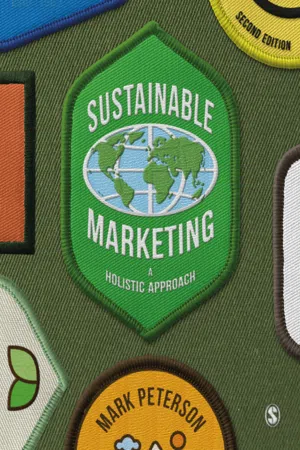
- 440 pages
- English
- ePUB (mobile friendly)
- Available on iOS & Android
About this book
Building on the idea that holistic marketing strategies allow firms to assess risk and realise opportunities, this book draws on new research and industry examples to help you recognize effective sustainability practices that benefit companies, stakeholders and society.
With an issue-based approach that dissects the interplay between marketing and society, the author encourages readers to critically engage with the changing nature of markets; how companies can adapt to sustainability guidelines and environmental threats while still remaining profitable in today's global market.
Using a range of examples including Costco, Juul, Facebook, Patagonia and Bitcoin, Peterson highlights the importance of social issues facing businesses today such as poverty alleviation, the drive towards more 'green' living, corporate social responsibility within firms and political pressures such as emissions guidelines and reducing the global carbon footprint.
The Mavericks Who Made It feature also highlights key entrepreneurs throughout history, their key successes and their impact on sustainable marketing.
Frequently asked questions
- Essential is ideal for learners and professionals who enjoy exploring a wide range of subjects. Access the Essential Library with 800,000+ trusted titles and best-sellers across business, personal growth, and the humanities. Includes unlimited reading time and Standard Read Aloud voice.
- Complete: Perfect for advanced learners and researchers needing full, unrestricted access. Unlock 1.4M+ books across hundreds of subjects, including academic and specialized titles. The Complete Plan also includes advanced features like Premium Read Aloud and Research Assistant.
Please note we cannot support devices running on iOS 13 and Android 7 or earlier. Learn more about using the app.
Information
PART I Macromarketing for Sustainable Marketing
1 Twenty-First-Century Micro and Macro Issues

The Air in Big Cities
Questions to Consider
- What factors led to having 25 times more diesels in Europe over a 20-year time span from 1998 to 2018?
- Do you think the European leaders who signed the Kyoto Protocol in 1997 to address climate change thought there would be such a surge in the adoption of diesels as there was?
- Are you surprised that there was so much more adoption of diesel cars in Europe than in the US?
- What does this story from Europe say about the effectiveness of government interventions in markets? About consumer preferences in transportation modes? About business’ role in auto markets?
Chapter Overview and Learning Objectives
- What are the seven reasons businesses are more mindful of society today?
- What is the definition of markets? Marketing? Society?
- What is macromarketing, and why is it important?
- What is the emerging view of capitalism and its five types of capital (manufactured, financial, natural, human, and social)?
- What role do entrepreneurs play in moving the marketplace toward generating social and environmental gains?
- How can social responsibility be integrated into a sustainable enterprise?
Sustainability and the Triple Bottom Line
What Is Driving the Turn for Businesses to Be Mindful of Society?
Reason 1: Technological Improvements
Reason 2: Rising Prosperity and Environmental Values
Reason 3: Awareness of Earth’s Limits
Table of contents
- Cover
- Half Title
- Publisher Note
- Title Page
- Copyright Page
- Acknowledgements
- Brief Contents
- Detailed Contents
- Author Biography
- Foreword
- Preface
- Online Resources
- PART I Macromarketing for Sustainable Marketing
- 1 Twenty-First-Century Micro and Macro Issues
- 2 Marketing and Society
- 3 Stakeholders in Marketing
- 4 The Role of Business in Society
- 5 The Role of the State in Society
- PART II Important Factors Affecting Sustainable Marketing
- 6 Globalization and Protectionism
- 7 Contemporary Consumers
- PART III Sustainable Marketing for the Environment
- 8 The Environmental Imperative
- 9 Environmentally Oriented Business
- 10 Sustainable Business Practices
- PART IV Sustainable Marketing for Equity
- 11 Developing Markets
- 12 Poverty Alleviation
- Index